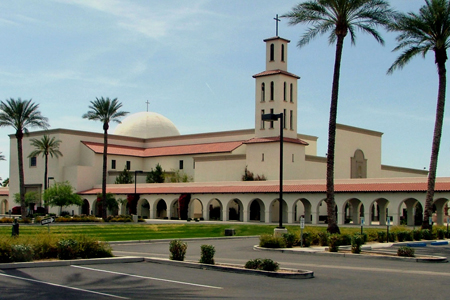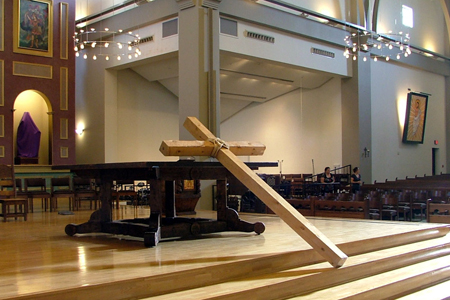| |
 |
 |
 |
| Comment on this report, or find other reports. |
 |
| Our Mystery Worshippers are volunteers who warm church pews for us around the world. If you'd like to become a Mystery Worshipper, start here. |
 |
| Find out how to reproduce this report in your church magazine or website. |
|
|
| 1919: St Thomas
Aquinas, Avondale, Arizona, USA |
 |
 |
 |
Mystery Worshipper:
Amanda B. Reckondwythe.
The church:
St Thomas Aquinas,
Avondale, Arizona, USA.
Denomination:
Roman Catholic, Diocese
of Phoenix.
The building:
A huge complex of buildings in the Southwest Mission style –
church, school, office and parish hall – connected via a cloister.
The church itself is large, with a dome soaring 85 feet above
the sanctuary and a 100 foot bell tower. It is cruciform, with
pews in the nave and transepts. To the left of the nave is a
cry room, to the right the Blessed Sacrament chapel with tabernacle
conspicuously empty. Behind the crossing, a large square altar
of dark oak sits in the center of a raised platform. To the
left is a baptismal chapel; to the right choir seating with
organ console, a grand piano and (alas) a drum set. Behind the
altar is a reredos featuring a large crucifix and two statues,
all of which were veiled in purple. Several shrines are positioned
in the side aisles, also with veiled statues. The walls are
lined with large oil-painted stations of the cross in the Mexican
folk art style.
The church: The parish began in the early 1900s as a small mission church and became an independent parish in 1975. Today they claim to be the largest Roman Catholic parish in Arizona. They sponsor several spiritual and social activities, including Bible study, marriage preparation, a charismatic prayer group, Knights of Columbus, a prison ministry, and many others. They are especially proud of their music program (and rightly so – see below), with youth, teen and adult choirs continuing the rich musical heritage of the Western church. They also sponsor Music and the Arts, a non-profit organization that reaches out to the local community with an eclectic program of sacred, classical and popular music.
The neighborhood:
Avondale is a western suburb of Phoenix. It was founded around
1880 by a certain Billy Moore, a renegade who (legend has it)
rode with the notorious Quantrill Gang, a band of Civil War
mercenaries. Moore built a railway freight station near a cold
water spring, naming it (not surprisingly) Coldwater Station.
With the addition of a saloon for those whose thirst just couldn’t
be slaked by cold water alone, Coldwater Station quickly became
a popular watering hole for stagecoach drivers. The Post Office
established a branch there in 1911, renaming the place Avondale
after a nearby ranch. Today, Avondale is a sprawling residential
and commercial suburb of about 80,000. It is home to Phoenix
International Raceway, a well-known auto race track. Each autumn
the city celebrates Billy More Heritage Days with a community
parade, carnival and street fair, although lately the event
has fallen victim to budget cuts.
The cast:
The liturgy was conducted by the Revd Thielo Ramirez, associate
pastor. He was assisted by the Revd Mr Milford Suida and the
Revd Mr Albert Scheller, deacons. A fourth cleric whose name
I could not ascertain served as subdeacon. There was also one
acolyte and two lay readers. Father Ramirez was vested in a
red chasuble, the deacons in red dalmatics, the subdeacon in
a red tunicle. The acolyte wore an alb and cincture. Matthew
Sprinkle, music director, conducted a choir of 15 mixed voices.
Mr Sprinkle was vested in cassock and surplice; the choir wore
black concert dress.
The date & time: Good Friday, April 2, 2010, 3.00pm.
What was the name of the service?
Service of the Lord’s Passion.
How full was the building?
The church is very large and can easily seat 600 in the nave and 500 in the transepts. It was completely full! I marveled at the size of the crowd for a Good Friday afternoon service.
Did anyone welcome you personally?
No.
Was your pew comfortable?
The pews were of dark wood with dark brown upholstery. They were very comfortable.
How would you describe the pre-service
atmosphere?
People entered quietly and knelt or sat in prayer. The choir were rehearsing. The clergy puttered about the altar with their preparations. Just before the service began, the choir moved from the choir seating area to chairs that had been set up behind the altar.
What were the exact opening words of the
service?
"Let us kneel."
What books did the congregation use during the
service?
There was an assortment of material in the pews, but we used a specially prepared service leaflet that contained everything – well, sort of (see below).
What musical instruments were played?
None, as is proper for Good Friday, not even to give the choir their pitches!

Did anything distract you?
Some people genuflected before the empty tabernacle in the Blessed Sacrament chapel as they entered (why?). Not all parents with noisy children availed themselves of the cry room. The liturgy didn’t always coincide with what was in the service leaflet – the leaflet omitted the solemn collects and reproaches, for example, and some of the responses were worded differently from what was actually said.
Was the worship stiff-upper-lip, happy clappy, or
what?
Solemn, dignified and inspiring. The clergy entered in silence
and prostrated themselves before the altar. The liturgy followed
the standard Good Friday order: lessons, passion, solemn collects,
veneration of the cross with reproaches, communion from the
reserved sacrament. The choir chanted the psalm to what sounded
very much like Anglican chant (more about this later). The passion
was recited by the officiant and the two deacons, but the choir
did not take the turba part as is customary – rather, the deacons
split it between themselves. The officiant chanted the solemn
collects in a lovely pure tenor voice. Three men carried in
a life-sized cross made of rough-hewn wood beams, and held it
erect for people to venerate. It looked very heavy and very
realistic, and one of the men especially looked like he was
rapidly tiring! After the veneration of the cross had concluded,
the cross was leaned up against the altar. There was no altar
of repose – the reserved sacrament was unceremoniously brought
to the altar from a credenza, and no candles were lit.
Exactly how long was the sermon?
9 minutes.
On a scale of 1-10, how good was the preacher?
7 – The sermon was very good but Father read it from papers he held in front of him.
In a nutshell, what was the sermon
about?
Good Friday makes sense only to Christians. "What kind
of god would let himself be killed?" non-Christians might
ask. "Wasn’t there a better way to reconcile a broken world?
Couldn’t God simply have made things better by a stroke of his
will? Did Christ have to die?" Even we Christians may ask
the same questions. The central truth of our faith is a paradox.
If the cross means only suffering and death, then our veneration
of it is misguided. But the cross is incomplete without the
resurrection, which changed the world for all time. It is a
gift from God, and our gift in return should be a grateful heart.
The power of Christ’s death and resurrection has made a clear
difference in our lives. Can we take that difference out of
church with us and into a broken world? Can we see hope? This
is our challenge as Christians: to embrace the passion in its
entirety, not merely to admire it from a distance.
Which part of the service was like being in
heaven?
This was one of the most dignified and moving Good Friday liturgies
I have experienced in a long time. The choir was simply magnificent!
Among their offerings were the spiritual "Were You There"; that
grand old Victorian seat-wetter, the Tertius Noble setting of
"Go to Dark Gethsemane"; Palestrina’s "Adoramus Te Christe"
(taken at twice the tempo it usually is); and others of similar
stature.
And which part was like being in... er... the other place?
But does the choir have to rehearse in church? Are there no
choir rooms? Especially on a day as somber as Good Friday, when
people are trying to meditate or pray, their rehearsal was most
distracting. Also distracting was the spectacle of at least
two choir members chugging water out of plastic bottles. At
least turn your backs, my dears, so we can’t see you.
What happened when you hung around after the service looking lost?
The clergy processed out in silence, followed by the congregation.
I asked the choir director, Matthew Sprinkle, if the music was
always that good, and several choir members replied with a resounding
"Yes!" I believe it! Mr Sprinkle and I had an extended
conversation about church music. He comes from an Episcopalian
background, which explains his good taste in liturgical music
and the Anglican chant-sounding psalm setting.
How would you describe the after-service
coffee?
There was none.
How would you feel about making this church your regular (where 10 = ecstatic, 0 = terminal)?
10 – If I were still Roman Catholic, I’d be there in a
flash! As it is, I’m sorely tempted. "We’re very high church
here," Mr Sprinkle told me. I mean, veiled statues during
Lent in a Catholic church? And a subdeacon? And Anglican chant?
Who could ask for anything more?
Did the service make you feel glad to be a
Christian?
Yes. From the clergy prostrating themselves to the veneration
of the cross, I was reminded that to be Christian is to be humble.
What one thing will you remember about all this in seven days' time?
The rough-hewn wooden cross leaned up against the altar. |
|
|
 |
 |
 |
| We rely on voluntary donations to stay online. If you're a regular visitor to Ship of Fools, please consider supporting us. |
 |
 |
 |
| The Mystery Pilgrim |
 |
| One of our most seasoned reporters makes the Camino pilgrimage to Santiago de Compostela in Spain. Read here. |
 |
 |
 |
| London churches |
 |
| Read reports from 70 London churches, visited by a small army of Mystery Worshippers on one single Sunday. Read here. |
| |
|
|
|
|


